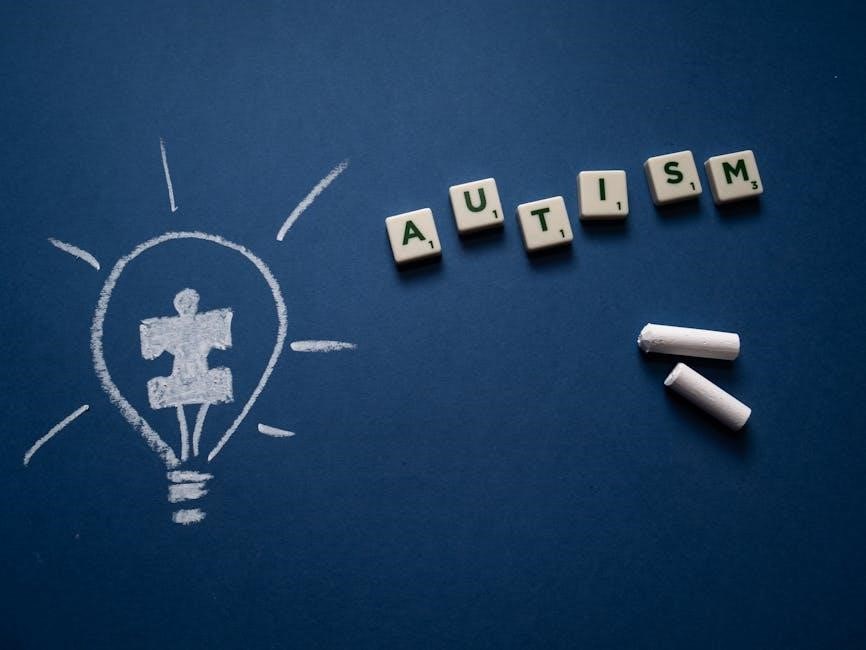
Autism presents unique challenges, particularly in following instructions, often due to cognitive, sensory, and communication difficulties. Understanding these obstacles is crucial for developing tailored strategies to support individuals with autism effectively.
Understanding Autism and Instruction Challenges
Autism Spectrum Disorder (ASD) is a developmental condition that impacts how individuals process information and interact with their environment. One common challenge is difficulty following instructions, which can stem from cognitive, sensory, or communication barriers. Many autistic individuals require clear, detailed guidance to understand expectations, as vague instructions can lead to confusion or non-compliance.
Sensory sensitivities and difficulties with social communication often complicate instruction-following. For example, overwhelming environments or unclear verbal cues can hinder comprehension. Additionally, some autistic individuals may struggle with initiating tasks or transitioning between activities, further impacting their ability to follow through on instructions.
Effective strategies, such as breaking instructions into smaller steps or using visual supports, can significantly improve understanding and compliance. Consistency and routine also play a crucial role in helping autistic individuals navigate instructional demands. By addressing these challenges thoughtfully, caregivers and educators can create supportive environments that foster success.

Understanding the Difficulty
Understanding the difficulty involves recognizing how autism affects processing instructions, often due to cognitive challenges, sensory sensitivities, and communication barriers. These factors can intertwine, creating unique obstacles that require personalized approaches in everyday tasks.
Definition of Autism
Autism, or Autism Spectrum Disorder (ASD), is a lifelong developmental condition that affects how individuals perceive and interact with the world. It impacts communication, social interaction, and behavior, often manifesting as delayed speech, social difficulties, and repetitive behaviors. ASD is characterized by challenges in verbal and nonverbal communication, alongside restricted or repetitive patterns of behavior or interests. The severity of symptoms varies widely, ranging from mild to severe, and each individual may experience unique difficulties. Understanding autism is essential for addressing the specific challenges faced by those with ASD, particularly in following instructions, which can be hindered by cognitive, sensory, and communication barriers. Recognizing the diverse nature of autism is crucial for providing tailored support and fostering inclusive environments.
I need to ensure the text is concise, within the word limit, and flows naturally. It should introduce the topic, outline the key challenges, and perhaps hint at the necessity of tailored strategies without going into details that will be covered elsewhere.
Let me start drafting:
Autism presents unique challenges when it comes to following instructions, often stemming from difficulties in understanding and processing information. Individuals with autism may struggle with interpreting both verbal and non-verbal cues, which can lead to confusion and non-compliance. Additionally, sensory sensitivities can create barriers, as overwhelming environments may hinder their ability to focus on the instructions being given. Communication challenges further exacerbate these difficulties, as some individuals may not grasp implied meanings or may need more time to process information. These obstacles highlight the importance of adapting instruction methods to meet the individual needs of those with autism, ensuring clarity, patience, and the use of supportive strategies to facilitate understanding and compliance.
Now, I’ll check the word count. Let me count the words:
Autism
presents
unique
challenges
when
it
comes
to
following
instructions,
often
stemming
from
difficulties
in
understanding
and
processing
information.
Individuals
with
autism
may
struggle
with
interpreting
both
verbal
and
non-verbal
cues,
which
can
lead
to
confusion
and
non-compliance.
Additionally,
sensory
sensitivities
can
create
barriers,
as
overwhelming
environments
may
hinder
their
ability
to
focus
on
the
instructions
being
given.
Communication
challenges
further
exacerbate
these
difficulties,
as
some
individuals
may
not
grasp
implied
meanings
or
may
need
more
time
to
process
information.
These
obstacles
highlight
the
importance
of
adapting
instruction
methods
to
meet
the
individual
needs
of
those
with
autism,
ensuring
100. clarity,
101. patience,
102. and
103. the
104. use
105. of
106. supportive
107. strategies
108. to
109. facilitate
110. understanding
111. and
112. compliance.
Okay, that’s . I need to reach . Let me expand on some points.
Perhaps adding more about the impact of sensory issues and communication challenges. Also, maybe include the need for structured routines or visual supports, but wait, I need to avoid overlapping with other subheadings like ‘Structured Routines’ or ‘Visual Supports’ which are under ‘Behavioral and Educational Strategies’ and ‘Effective Communication Strategies’ respectively.
So, I should focus on giving an overview without diving into specific strategies. Maybe mention the necessity of tailored approaches without detailing them.
Let me revise:
Autism presents unique challenges when it comes to following instructions, often stemming from difficulties in understanding and processing information. Individuals with autism may struggle with interpreting both verbal and non-verbal cues, which can lead to confusion and non-compliance. Additionally, sensory sensitivities can create barriers, as overwhelming environments may hinder their ability to focus on the instructions being given. Communication challenges further exacerbate these difficulties, as some individuals may not grasp implied meanings or may need more time to process information. These obstacles highlight the importance of adapting instruction methods to meet the individual needs of those with autism, ensuring clarity, patience, and the use of supportive strategies to facilitate understanding and compliance. Tailored approaches, considering sensory and communication needs, are essential for effective instruction.
Now, let’s count again:
Autism
presents
unique
challenges
when
it
comes
to
following
instructions,
often
stemming
from
difficulties
in
understanding
and
processing
information.
Individuals
with
autism
may
struggle
with
interpreting
both
verbal
and
non-verbal
cues,
which
can
lead
to
confusion
and
non-compliance.
Additionally,
sensory
sensitivities
can
create
barriers,
as
overwhelming
environments
may
hinder
their
ability
to
focus
on
the
instructions
being
given.
Communication
challenges
further
exacerbate
these
difficulties,
as
some
individuals
may
not
grasp
implied
meanings
or
may
need
more
time
to
process
information.
These
obstacles
highlight
the
importance
of
adapting
instruction
methods
to
meet
the
individual
needs
of
those
with
autism,
ensuring
100. clarity,
101. patience,
102. and
103. the
104. use
105. of
106. supportive
107. strategies
108. to
109. facilitate
110. understanding
111. and
112. compliance.
113. Tailored
114. approaches,
115. considering
116. sensory
117. and
118. communication
119; needs,
120. are
121. essential
122. for
123. effective
124. instruction.
Now, that’s . Still need 46 more words to reach 170.
I can elaborate on the impact of these challenges and the necessity of understanding them to develop appropriate support systems.
Continuing:
Understanding these challenges is crucial for educators and caregivers to develop appropriate support systems. By recognizing the diverse needs of individuals with autism, tailored strategies can be implemented to enhance their ability to follow instructions effectively. This not only aids in their educational development but also fosters a more inclusive and supportive environment.
Let me add this:
Autism presents unique challenges when it comes to following instructions, often stemming from difficulties in understanding and processing information. Individuals with autism may struggle with interpreting both verbal and non-verbal cues, which can lead to confusion and non-compliance. Additionally, sensory sensitivities can create barriers, as overwhelming environments may hinder their ability to focus on the instructions being given. Communication challenges further exacerbate these difficulties, as some individuals may not grasp implied meanings or may need more time to process information. These obstacles highlight the importance of adapting instruction methods to meet the individual needs of those with autism, ensuring clarity, patience, and the use of supportive strategies to facilitate understanding and compliance. Tailored approaches, considering sensory and communication needs, are essential for effective instruction. Understanding these challenges is crucial for educators and caregivers to develop appropriate support systems. By recognizing the diverse needs of individuals with autism, tailored strategies can be implemented to enhance their ability to follow instructions effectively. This not only aids in their educational development but also fosters a more inclusive and supportive environment.
Now, let’s count:
Autism
presents
unique
challenges
when
it
comes
to
following
instructions,
often
stemming
from
difficulties
in
understanding
and
processing

Common Challenges
Individuals with autism often face cognitive, sensory, and communication difficulties that hinder their ability to follow instructions. These challenges can lead to confusion, non-compliance, and frustration, requiring tailored strategies for effective support.
Cognitive Difficulties
Cognitive challenges are a significant barrier for individuals with autism when following instructions. Processing information can be slower, and understanding complex directions may lead to confusion. Many autistic individuals benefit from detailed explanations and clear, step-by-step guidance to avoid misunderstandings. Additionally, working memory limitations can make it difficult to retain and execute multi-step instructions without visual or tactile supports. These cognitive differences often require patience and tailored approaches to ensure comprehension and successful task completion.
Sensory Issues
Sensory sensitivities often complicate an autistic individual’s ability to follow instructions. Overwhelming environmental stimuli, such as loud noises or bright lights, can distract and hinder focus. Some may experience sensory overload, making it difficult to process verbal cues. Tactile sensitivities might also affect participation in hands-on activities. To address these challenges, creating a calm, controlled environment is essential. Using visual aids or written instructions can help bypass auditory sensitivities, while incorporating sensory-friendly tools can make tasks more accessible. Understanding and accommodating these sensory needs is crucial for effective communication and instruction.
Communication Problems
Communication challenges are a significant barrier for many autistic individuals when following instructions. Difficulties in understanding verbal and non-verbal cues, such as tone of voice or body language, can lead to confusion. Some may struggle with interpreting sarcasm, idioms, or abstract language, requiring explicit and literal explanations. Additionally, challenges in initiating or maintaining conversations can hinder clarification of instructions. Many autistic individuals benefit from clear, concise communication, avoiding ambiguity. Visual supports, such as written instructions or diagrams, can enhance understanding. Providing extra time to process information and allowing opportunities for questions can also improve compliance. Addressing these communication challenges is essential for fostering effective instruction and collaboration. Tailoring communication strategies to individual needs ensures better outcomes and reduces frustration for both the individual and the instructor.

Effective Communication Strategies
Effective communication strategies are vital for helping autistic individuals follow instructions. Using clear, structured language and visual supports can enhance understanding. Breaking tasks into smaller steps and providing consistent feedback also promotes success and builds confidence.
Clear Instructions
Clear instructions are essential for individuals with autism to follow directions effectively. Breaking down tasks into simple, manageable steps helps reduce confusion. Using specific, direct language avoids ambiguity, ensuring the individual understands what is expected. Vague terms like “be careful” should be replaced with explicit directions, such as “walk slowly and stay on the path.” Providing visual examples or demonstrations can further clarify expectations; Consistency in wording and delivery also plays a key role, as it helps establish predictable patterns that autistic individuals can rely on. Additionally, allowing time for processing and avoiding rushed decisions can significantly improve comprehension and compliance. Offering choices within structured boundaries fosters independence while maintaining clarity. By tailoring instructions to individual needs and learning styles, educators and caregivers can create a more supportive and effective learning environment.
These strategies not only enhance understanding but also build confidence and reduce anxiety related to following instructions.
Visual Supports
Visual supports are highly effective tools for helping individuals with autism follow instructions. These tools provide clear, concrete representations of tasks, routines, or expectations, reducing confusion and anxiety. Common examples include visual schedules, choice boards, and task charts. Visual schedules help individuals understand the sequence of events, making transitions smoother. Choice boards allow individuals to select activities, fostering independence and reducing resistance. Task charts break down complex instructions into manageable steps, using images or symbols to convey each action. These supports can also incorporate the individual’s interests to increase engagement. Digital tools, such as apps, offer interactive and customizable options, while physical supports like checklists provide tactile reinforcement. Consistency is key; using the same symbols and layouts across environments helps maintain familiarity. Visual supports not only enhance comprehension but also empower individuals with autism to navigate tasks independently. By aligning with their learning style, these tools create a more accessible and inclusive environment.

Behavioral and Educational Strategies
Behavioral and educational strategies focus on creating structured, supportive environments. Techniques like positive reinforcement encourage desired behaviors, while structured routines provide predictability, helping individuals with autism follow instructions more effectively and confidently.
Positive Reinforcement
Positive reinforcement is a powerful strategy to encourage desired behaviors in individuals with autism. By associating compliant actions with rewards, such as praise, stickers, or small treats, individuals learn to connect following instructions with positive outcomes. This method, often used in Applied Behavior Analysis (ABA) therapy, helps build confidence and motivation. Consistency is key, as unpredictable reinforcement can lead to confusion. Over time, the frequency of rewards can be reduced as behaviors become habitual. Visual rewards, like token systems, can also be effective, especially for those who respond well to visual cues. Positive reinforcement not only improves instruction-following but also fosters a supportive and encouraging environment. It is essential to tailor rewards to the individual’s preferences to maximize effectiveness. By focusing on positive outcomes, this approach helps individuals with autism develop self-confidence and a willingness to engage in learning and social interactions.
Structured Routines
Structured routines play a vital role in helping individuals with autism follow instructions more effectively. Predictable schedules and clear expectations provide a sense of stability, reducing anxiety and uncertainty. Visual tools, such as daily timetables or checklists, can help break tasks into manageable steps. For example, using a first-then chart to indicate the sequence of activities (“First, we do homework, then we play”) can make transitions smoother. Consistency in routines also helps individuals understand what is expected of them, minimizing confusion. Additionally, incorporating visual supports, like symbols or images, can enhance comprehension for those with sensory or communication challenges. Over time, structured routines can build independence and self-confidence, as individuals learn to anticipate and complete tasks without constant supervision. Adaptability is key, as routines may need to be adjusted to accommodate individual preferences or unexpected changes. By creating a structured environment, caregivers and educators can foster a sense of control and predictability, making it easier for individuals with autism to navigate daily tasks and instructions.

Advanced Support Techniques
Advanced support techniques involve integrating technology and modifying environments to aid individuals with autism. Tools like apps provide detailed instructions, while sensory-friendly spaces reduce overwhelm, fostering better understanding and compliance with directions.
Technology Integration
Technology integration has emerged as a powerful tool to support individuals with autism in following instructions. Apps and interactive platforms provide visual and step-by-step guides, breaking down complex tasks into manageable parts. Augmented reality tools can simulate real-life scenarios, helping individuals understand expectations. Customizable settings allow for tailored support, such as adjustable font sizes, color schemes, and audio cues. Many apps incorporate positive reinforcement, offering rewards like badges or animations to encourage task completion. Additionally, speech-to-text and text-to-speech features assist those with communication challenges. These tools not only enhance comprehension but also build confidence. For instance, apps like Choiceworks and First-Then visualize schedules and tasks, reducing anxiety. Technology also fosters independence by providing immediate feedback, enabling individuals to self-correct. Overall, technology integration offers personalized, engaging, and effective solutions to address difficulties in following instructions.
Environmental Modifications
Environmental modifications play a crucial role in helping individuals with autism follow instructions more effectively. Creating a structured and predictable physical space minimizes sensory overload, a common barrier to understanding and executing tasks. For instance, reducing noise levels or using natural lighting can create a calming atmosphere, which enhances focus. Organizing workstations with clear visual cues, such as labeled bins or charts, helps individuals understand expectations. Incorporating flexible seating options, like fidget chairs or standing desks, allows individuals to move comfortably, reducing restlessness. Additionally, visual schedules and checklists placed strategically around the environment provide constant reminders of tasks and routines. These modifications not only improve comprehension but also reduce anxiety related to uncertainty. By tailoring the environment to individual needs, caregivers and educators can create a supportive space where instructions are easier to follow and execute. Such adjustments are essential for fostering independence and confidence in daily activities.

The Role of Caregivers and Educators
Caregivers and educators play a vital role in supporting individuals with autism. They provide structured routines, clear communication, and positive reinforcement, creating a stable environment that fosters understanding and task execution. Their collaboration ensures consistent support.
Parental Involvement
Parental involvement is crucial in addressing the challenges autistic individuals face with following instructions. Parents often serve as the primary source of support, providing a consistent and nurturing environment that fosters understanding and cooperation. By working closely with educators and therapists, parents can ensure that strategies for improving instruction-following skills are implemented both at home and in school. This collaboration helps create a seamless support system tailored to the child’s needs.
Parents can also play a key role in identifying triggers that may hinder their child’s ability to follow directions. By understanding these triggers, they can adapt their communication style and daily routines to minimize frustrations. Additionally, parents can reinforce positive behaviors through praise and encouragement, helping their child build confidence and self-esteem. Emotional support and patience are essential, as navigating these challenges can be overwhelming for both the child and the family.
Ultimately, parental involvement not only enhances the effectiveness of instructional strategies but also strengthens the bond between parent and child, creating a foundation for long-term growth and development.
School Support Systems
School support systems are vital for helping autistic students overcome difficulties with following instructions. These systems often include individualized education plans (IEPs), which outline specific accommodations and strategies tailored to each student’s needs. Teachers and staff receive training to understand autism-related challenges, enabling them to provide appropriate support in the classroom.
Structural interventions, such as visual schedules and clear communication, are commonly implemented to aid students in understanding and completing tasks. Additionally, behavioral support specialists may work with students to develop coping mechanisms and improve their ability to follow directions. Peer mentoring programs can also play a role, fostering a supportive environment where students with autism feel comfortable asking for help.
Regular communication between teachers and parents ensures consistency in applying these strategies both at school and home. By integrating these support systems, schools create an inclusive and effective learning environment that addresses the unique challenges faced by autistic students.

Community and Workplace Accommodations
Community and workplace accommodations for autism include sensory-friendly environments, clear communication, and flexible deadlines. Public awareness campaigns promote understanding, while workplace adjustments like structured routines and technology tools enhance productivity and inclusion for autistic individuals.
Public Awareness Campaigns
Public awareness campaigns play a vital role in fostering understanding and acceptance of autism. By educating communities about the challenges autistic individuals face, particularly with following instructions, these campaigns help reduce stigma and promote inclusion. Many campaigns utilize educational materials, workshops, and media outreach to highlight the importance of clear communication and sensory-friendly environments. They also emphasize the need for patience and accommodations in both community and workplace settings. These initiatives often feature personal stories and experiences of autistic individuals, providing relatable insights into their daily struggles and strengths. By breaking down stereotypes and misconceptions, public awareness campaigns encourage a more supportive and inclusive society. They also empower caregivers and educators with practical strategies to assist autistic individuals effectively. Ultimately, these efforts contribute to creating environments where autistic individuals can thrive and reach their full potential without facing unnecessary barriers. The impact of such campaigns is profound, leading to more compassionate and accommodating communities worldwide.
Workplace Adjustments
Workplace adjustments are essential for supporting individuals with autism, particularly in addressing difficulties with following instructions. Employers can implement several strategies to create a more inclusive environment. Providing clear, detailed instructions in both verbal and written formats helps ensure understanding. Visual aids, such as checklists or flowcharts, can also clarify expectations and reduce confusion. Structured routines and predictable schedules can minimize anxiety and improve task completion. Additionally, sensory-friendly workspaces, including noise-cancelling headphones or flexible lighting, can enhance focus and productivity. Employers should also consider offering regular feedback and one-on-one support to address any challenges. Training staff on autism awareness fosters a more understanding and accommodating workplace culture. By making these adjustments, employers can help autistic employees thrive, leveraging their unique strengths and contributions. These accommodations not only benefit individuals with autism but also promote a more inclusive and diverse workplace overall, leading to greater employee satisfaction and productivity.